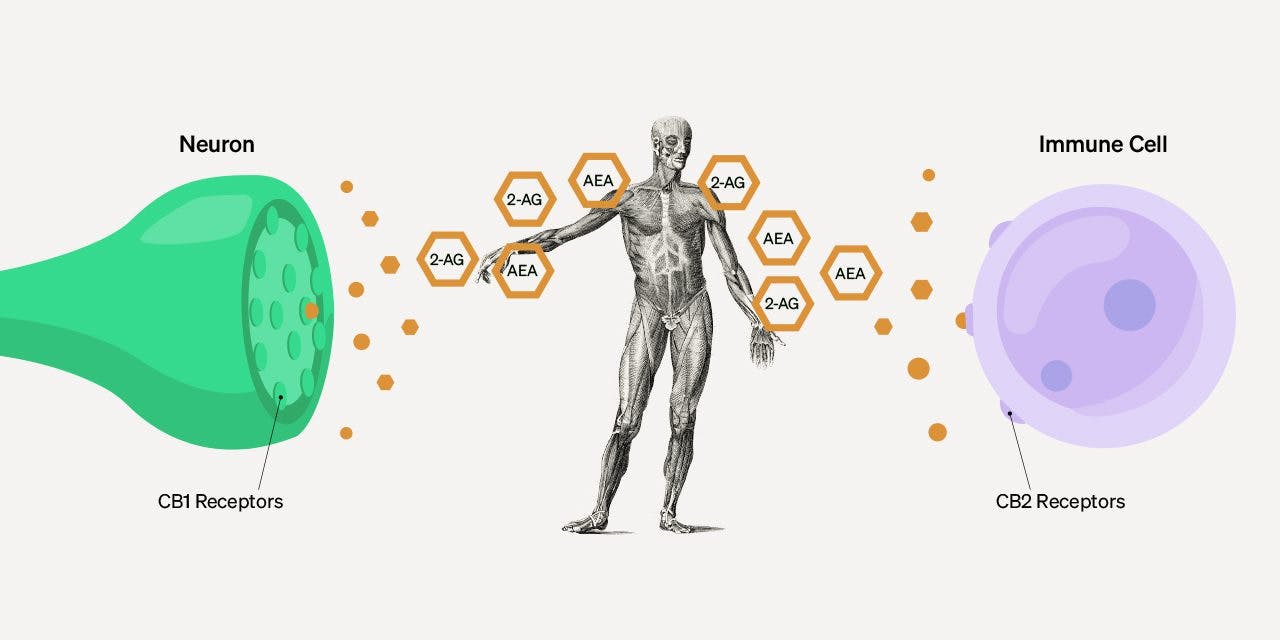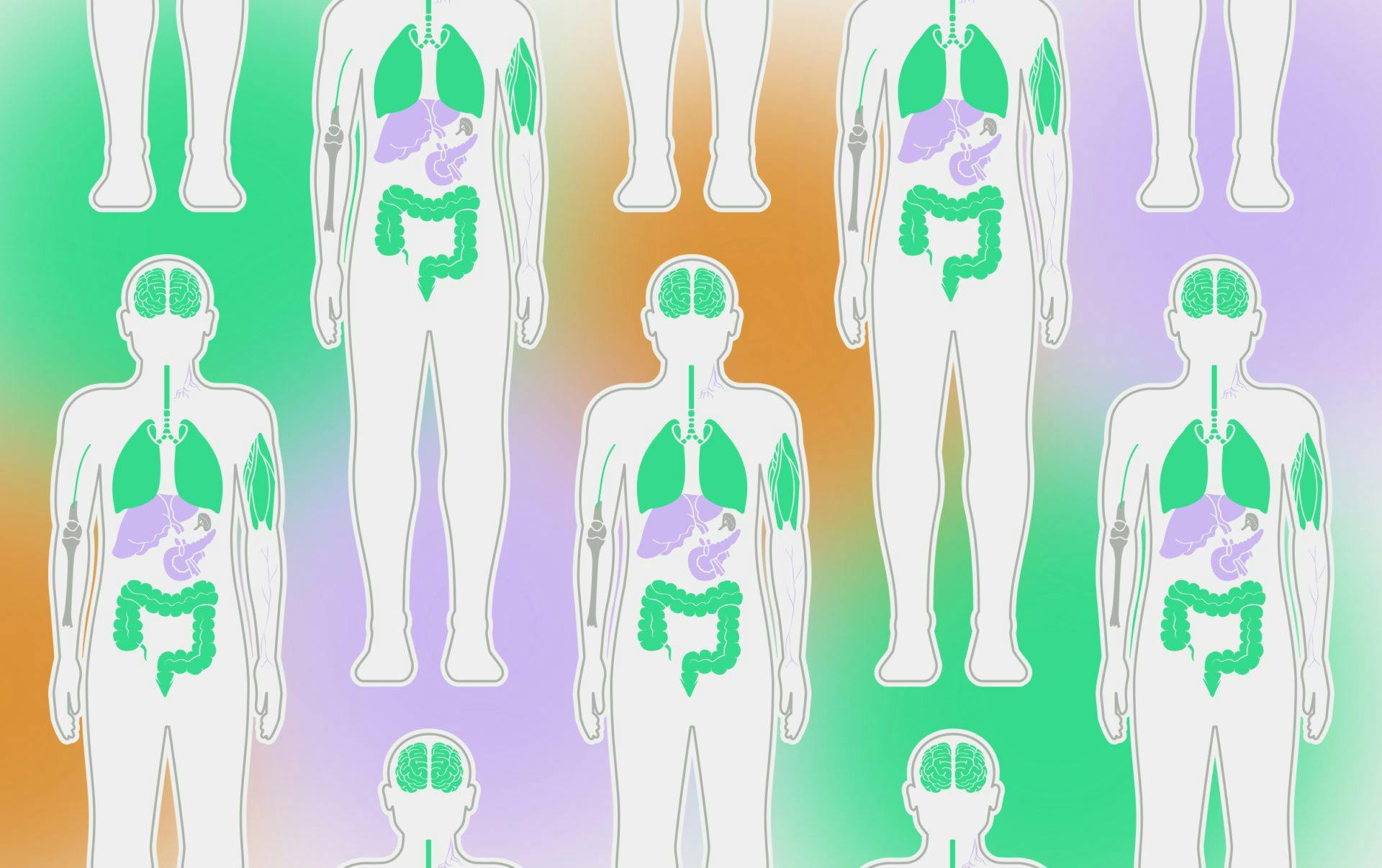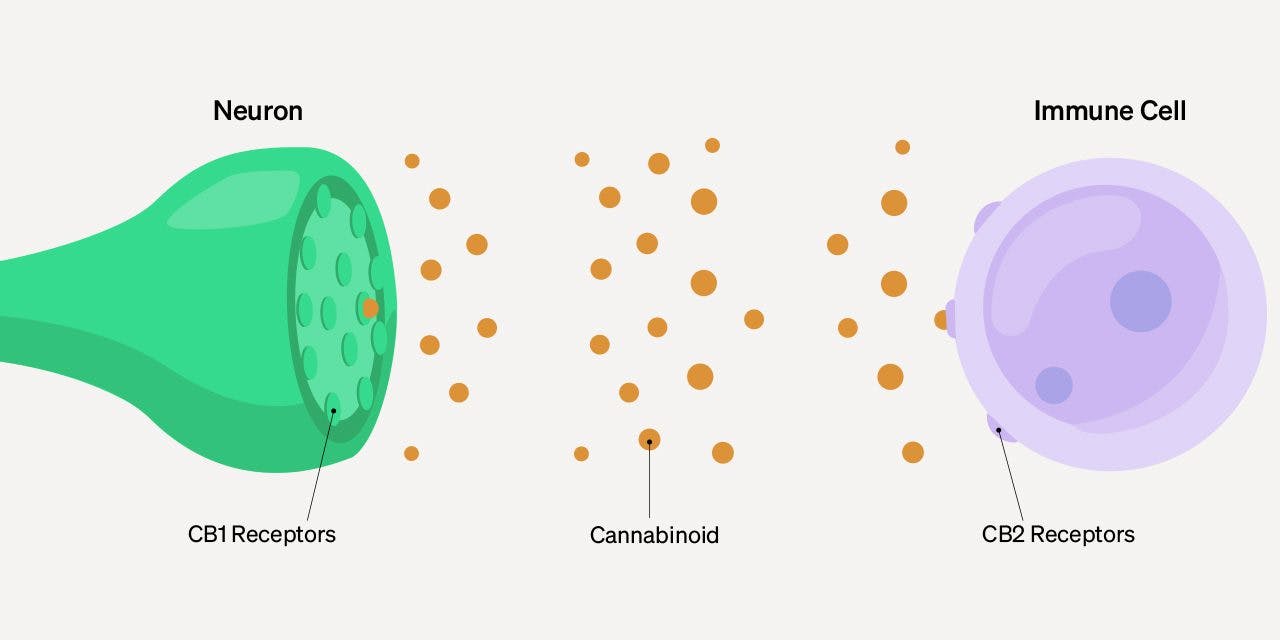The Complete Guide to Endocannabinoids

Article written by

Dipak HemrajHead of Research and Education
Content reviewed by

Dr. Lewis JasseyMedical Director - Pediatric Medicine
Endocannabinoids are molecules that play a role in making sure your body functions properly. They have several therapeutic uses, including helping to regulate inflammation, stress, and pain. Let’s learn more about them and how they work in the human body.
Get your medical marijuana card
Connect with a licensed physician online in minutes.
What Are Endocannabinoids?
Endocannabinoids or “endogenous cannabinoids” are neurotransmitters (chemical messengers) made by your endocannabinoid system (ECS). They affect behavior and cognition in a similar manner to THC — one of the main cannabinoids found in cannabis — but are produced within the body.
The two most studied endocannabinoids are anandamide (AEA) and 2-arachidonoyl glycerol (2-AG). There are additional endocannabinoids, virodhamine, and 2-arachidonoyl glycerol ether, but these are not as well researched.
Download Free Guide to the ECS
What’s the Difference Between Endocannabinoids, Cannabinoids, and Phytocannabinoids?
There’s a lot to learn about the ECS, including how cannabinoids, endocannabinoids, and phytocannabinoids differ. Basically: endocannabinoids and phytocannabinoids are types of cannabinoids. The most significant difference between them is that your body makes endocannabinoids, whereas phytocannabinoids come from plants.
Here is a bit more information about each of these compounds:
Cannabinoids
Cannabinoids are a class of molecules that contain a carboxyl group. This covers both endocannabinoids and phytocannabinoids. All cannabinoids have an active constituent that binds (attaches) to the cannabinoid receptors (CB1 and CB2) within the brain and body or influences the behavior of cannabinoid receptors in some way if they do not bind to them directly.
Free Infographic Guide to Cannabinoids
Endocannabinoids
Endocannabinoids are a sub-group of cannabinoids that are made in the body. The two most important and well-studied endocannabinoids are anandamide (AEA) and 2-arachidonoyl glycerol (2-AG).
Phytocannabinoids
Phytocannabinoids are a sub-group of cannabinoids that come from plants, specifically cannabis plants. There are over 150 different phytocannabinoids that have been discovered in cannabis plants, the most well-known being THC and CBD.
THC is a psychoactive, intoxicating cannabinoid. When it binds to the CB1 receptors in the brain, it causes the “high” feeling commonly associated with cannabis ingestion. CBD does not have the same psychoactive effects as THC; however, it produces a lot of therapeutic benefits.
How Endocannabinoids Work
Endocannabinoids bind to the CB1 and CB2 receptors. CB1 receptors are found predominantly throughout the brain and central nervous system (CNS), and CB2 receptors are most commonly found within the immune system and peripheral nervous system.
Endocannabinoids can bind to either cannabinoid receptor and elicit a different response from each type. If an endocannabinoid binds to a CB1 receptor in the CNS, it may help to relieve pain. In contrast, an endocannabinoid that attaches to a CB2 receptor in the immune system might help relieve symptoms of inflammation.
How They’re Created
Endocannabinoids are made from lipid membranes in the body. When the right signals occur, the endocannabinoids are “synthesized” and released into the body.
The process that initiates the synthesis of endocannabinoids is not completely clear, though it is believed to involve an elevation of calcium inside the cells. It is also thought that the synthesis of each endocannabinoid is exclusive, meaning that different signals cause the synthesis of each endocannabinoid. In other words, anandamide (AEA) and 2-arachidonoyl glycerol (2-AG) are not created simultaneously.
Functions, Benefits, and Therapeutic Uses
Functions
Although the full extent of the functions of the endocannabinoid system (ECS) is unknown, it is thought that the ECS plays a role in maintaining homeostasis. Homeostasis is a process in which the body regulates physiological functions such as body temperature and blood sugar to ensure the body continues functioning as expected, even when external conditions change.
Specific parts of homeostasis that the ECS is thought to assist in regulating include:
- Appetite and digestion
- Inflammation and immune responses
- Memory and learning
- Metabolism
- Mood
- Reproductive system functioning
- Sleep
- Transporting signals around the body, such as the sensation of pain and pleasure
The endocannabinoid system also plays an important role in the development of the brain and its synapses. Synapses are electrical connections within the brain that neurotransmitters (such as endocannabinoids) travel across to send information around the body.
Therapeutic Uses
Each endocannabinoid affects the body differently. 2-arachidonoyl glycerol, or 2-AG, is the most prevalent endocannabinoid, and it manages appetite, immune system regulation, and pain response.
Anandamide, or AEA, is the chemical that causes the “runner’s high” you may experience after exercises such as running or even meditation and yoga.
When cannabis is ingested, the phytocannabinoids (cannabinoids from the cannabis) bind to the endocannabinoids to exert their effects. The specific effects of the phytocannabinoids depend on which cannabinoid is ingested and which receptor it binds to.
These therapeutic effects include:
- Pain relief
- Anti-inflammatory
- Anti-nausea
- Appetite stimulation
- Mood stabilization
- Anti-anxiety
- Antidepressant
- Multiple sclerosis treatment
- Epilepsy treatment
Some conditions, such as IBS and Crohn’s disease, result from chronic inflammation caused by an imbalance in homeostasis. As the endocannabinoid system is believed to play a role in regulating the inflammatory response, endocannabinoids and phytocannabinoids may help to reduce inflammation in these conditions.
The Bottom Line
Endocannabinoids are neurotransmitters produced by the endocannabinoid system within the body. These molecules play a role in maintaining homeostasis. Their structure is similar to phytocannabinoids (cannabinoids in cannabis), and they exert their effects on the body via the same receptors.
Get Your Medical Card
Connect with a licensed physician online in minutes.


